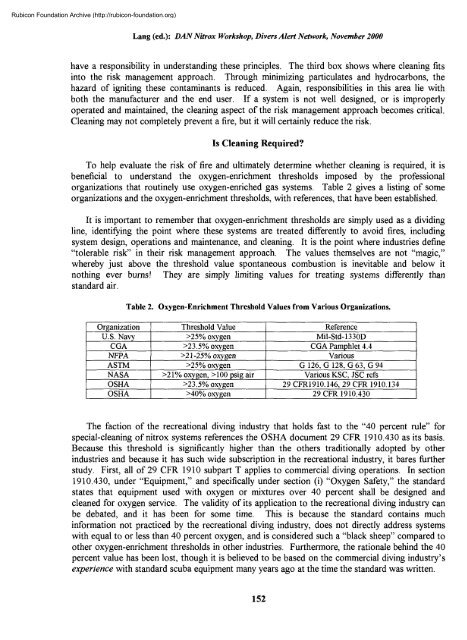Nitrox workshop dings - Divers Alert Network
Nitrox workshop dings - Divers Alert Network
Nitrox workshop dings - Divers Alert Network
Create successful ePaper yourself
Turn your PDF publications into a flip-book with our unique Google optimized e-Paper software.
Rubicon Foundation Archive (http://rubicon-foundation.org)Lang (ed.): DAN <strong>Nitrox</strong> Workshop, <strong>Divers</strong> <strong>Alert</strong> <strong>Network</strong>, November 2000have a responsibility in understanding these principles. The third box shows where cleaning fitsinto the risk management approach. Through minimizing particulates and hydrocarbons, thehazard of igniting these contaminants is reduced. Again, responsibilities in this area lie withboth the manufacturer and the end user. If a system is not well designed, or is improperlyoperated and maintained, the cleaning aspect of the risk management approach becomes critical.Cleaning may not completely prevent a fire, but it will certainly reduce the risk.Is Cleaning Required?To help evaluate the risk of fire and ultimately determine whether cleaning is required, it isbeneficial to understand the oxygen-enrichment thresholds imposed by the professionalorganizations that routinely use oxygen-enriched gas systems. Table 2 gives a listing of someorganizations and the oxygen-enrichment thresholds, with references, that have been established.It is important to remember that oxygen-enrichment thresholds are simply used as a dividingline, identifying the point where these systems are treated differently to avoid fires, inclu<strong>dings</strong>ystem design, operations and maintenance, and cleaning. It is the point where industries define"tolerable risk" in their risk management approach. The values themselves are not "magic,"whereby just above the threshold value spontaneous combustion is inevitable and below itnothing ever burns! They are simply limiting values for treating systems differently thanstandard air.Table 2. Oxygen-Enrichment Threshold Values from Various Organizations.OrganizationU.S. NavyCGANFPAASTMNASAOSHAOSHAThreshold Value>25% oxygen>23.5% oxygen>21-25% oxygen>25% oxygen>21% oxygen, >100 psig air>23.5% oxygen>40% oxygenReferenceMil-Std-1330DCGA Pamphlet 4.4VariousG 126, G 128, G 63, G 94Various KSC, JSC refs29 CFR1910.146, 29 CFR 1910.13429 CFR 1910.430The faction of the recreational diving industry that holds fast to the "40 percent rule" forspecial-cleaning of nitrox systems references the OSHA document 29 CFR 1910.430 as its basis.Because this threshold is significantly higher than the others traditionally adopted by otherindustries and because it has such wide subscription in the recreational industry, it bares furtherstudy. First, all of 29 CFR 1910 subpart T applies to commercial diving operations. In section1910.430, under "Equipment," and specifically under section (i) "Oxygen Safety," the standardstates that equipment used with oxygen or mixtures over 40 percent shall be designed andcleaned for oxygen service. The validity of its application to the recreational diving industry canbe debated, and it has been for some time. This is because the standard contains muchinformation not practiced by the recreational diving industry, does not directly address systemswith equal to or less than 40 percent oxygen, and is considered such a "black sheep" compared toother oxygen-enrichment thresholds in other industries. Furthermore, the rationale behind the 40percent value has been lost, though it is believed to be based on the commercial diving industry'sexperience with standard scuba equipment many years ago at the time the standard was written.152
















